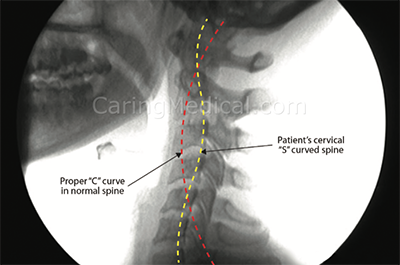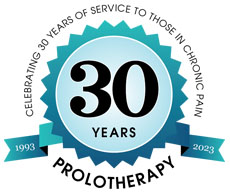
Some of us have lost our girlish figures, but that is not what we are talking about here!
We have been treating patients’ ligament and tendon injuries to every area of the body for 30+ years at Caring Medical – low backs, knees, elbows, TMJs, wrists, ankles, toes, shoulders, hips, pelvis, and of course, necks. However, in recent years, we have seen an astounding increase in neck or cervical spine injuries, causing people to develop a wide array of symptoms that patients may not realize come from injuries to the neck – causing them to lose their healthy neck curves.
Why? It is our opinion that the dreaded “facedown lifestyle” is the culprit leading to ligament creep – a condition where ligaments start to stretch and stretch until they are no longer able to handle the load. A whiplash-type injury from a fall, car accident, sports injury, or even coughing may lead to worsening of the cervical injury, resulting in cervical spine abnormalities with eventual cervical dysstructure and pain.
Let’s look at the types of curvatures of the neck that we see. You can see pictures of these on our CaringMedical.com website if you want more information.
The lordotic curve (or the C curve) is the correct curve of your neck. As injuries continue, cervical vertebrae then sublux, or move, and you see a gradual loss of lordosis to a straightening or military curve, an eventual reverse curve or Kyphotic curve, and eventually a reversal of the curve or an “S” curve signifying spinal instability.
You may ask, well, does it matter if I have lost my natural lordotic curve?
Some patients that we see may be walking around with loss of their cervical curves and remain completely asymptomatic. That is, until something happens!
Discs begin to narrow between the C3-C4, C4-C5, and C5-C6 segments, as well as at the upper cervical levels. Strange sensations begin to develop such as headaches, neck pain, dizziness, tingling down the arms, brain fog, ear fullness, blurry vision, feeling of spinning, ringing in the ears, and many more. As this condition worsens, some patients experience even more terrible symptoms such as heart arrhythmias, fluctuations in blood pressure, GI disturbances, and brain problems.
When the force per unit area becomes greater than the strength of the tissue, the results are tissue injury and pain. Since joint instability is the cause of almost all chronic pain, curing chronic pain involves tightening the loose joints by stimulating the appropriate ligaments to tighten, and thus resolving the destructive joint forces. As tissue further weakens, destructive joint motions are produced every time the joint is used, creating a vicious cycle of worsening joint destruction and pain.
At Caring Medical, we document cervical instability utilizing digital motion x-ray, along with physical exam and other modalities. Healing protocols include regenerative injection treatments, such as Prolotherapy from one of our skilled Prolotherapists and/or Cervical Realignment Therapy for curve correction, as well as instructions for what to do at home, such as sitting with shoulders and chin back and tummies tucked in, standing regularly (vs sitting), especially if you work at a computer for a long time, getting regular exercise, and most certainly implementing a dramatic reduction in cellular device usage in the facedown position!
So, if you have lost your curve, remember that there are ways to get it back!



